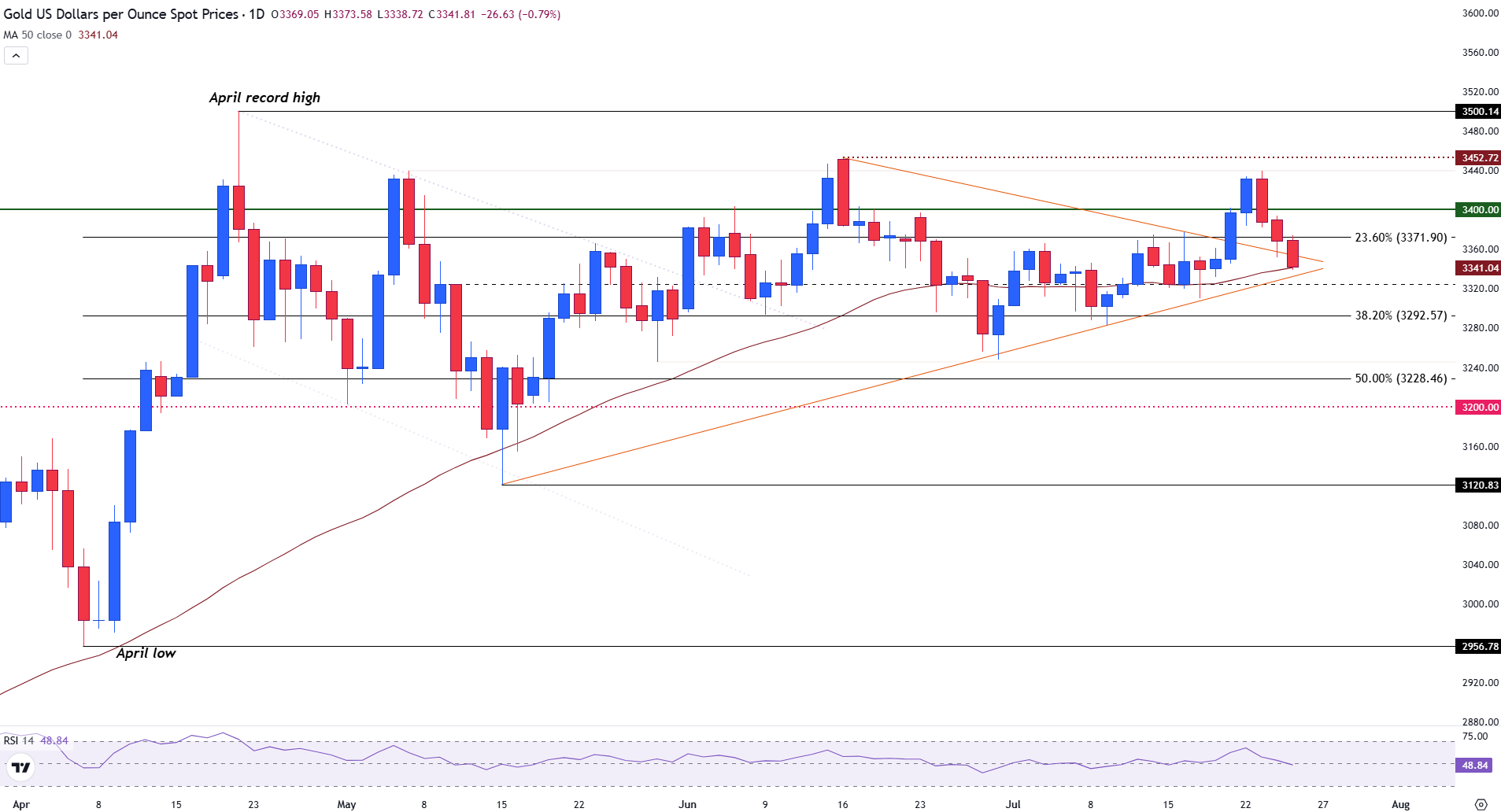Created
: 2025.07.25














![]() 2025.07.25 21:40
2025.07.25 21:40
Gold is trading lower on Friday as risk appetite improves, trade tensions ease, and the US Dollar firms.
At the time of writing, XAU/USD is hovering near $3,340, weighed down by rising US Treasury yields and fading demand for safe-haven assets.
Robust earnings, resilient macro data, and fading demand for safe-haven assets have all weighed on Bullion this week. Physical demand from Asia remains subdued, while broader market stability has limited upside for the yellow metal. From a technical view, sellers appear to be regaining control, with Gold easing back from earlier highs near $3,349.
The easing of global trade tensions has been a central driver of this week's pullback in Gold. US President Donald Trump has signaled that countries offering greater access to US markets could receive preferential tariff treatment, citing the recently concluded Japan trade agreement as a model for ongoing negotiations with the European Union.
Under the proposed deal, most EU goods would face a 15% baseline tariff, a notable reduction from the 30% rate scheduled to take effect on August 1 if no agreement is reached.
Attention is also turning to next week's high-stakes US-China trade talks. Treasury Secretary Scott Bessent will meet Chinese Vice Premier He Lifeng in Stockholm between Sunday and Tuesday to discuss extending the current tariff truce, which is set to expire on August 12.
Under the current agreement, tariffs on US imports of Chinese goods are subject to a 55% total tariff rate, while Chinese imports of US goods face a levy of 10%. The 55% tariff rate consists of a 10% baseline tariff, a 20% "fentanyl" tariff, and a 25% Section 301 tariff. The upcoming meetings in Stockholm will focus on potentially extending this truce and addressing other economic issues.
Should talks collapse, tariff rates would revert to 145% on Chinese imports and 125% on US exports, a development that could trigger a sharp deterioration in risk sentiment and reignite safe-haven demand for Gold.
Meanwhile, Chinese Commerce Minister Wang Wentao has expressed support for improving trade ties with the US, noting the mutual interest in restoring long-term economic stability. His comments helped ease market fears earlier in the week, reinforcing the broader risk-on environment.
Gold is edging lower after failing to hold above the 23.6% Fibonacci retracement of the April low-high move at $3,371. With the price currently clinging to the 50-day Simple Moving Average (SMA) at $3,341, XAU/USD is edging toward the lower bound of the ascending triangle, which was temporarily broken earlier this week.
The next key level of support is located at the 38.2% Fibo level around $3,292. A break below this zone could expose deeper downside toward the 50% retracement near $3,228.
Momentum has also weakened, with the Relative Strength Index (RSI) hovering just below neutral at 48, signaling growing downside risk if buyers fail to defend the current support zone.

Gold daily chart
For bulls to recover, a move above the $3,350 level and a clear break of $3,372 could open the door for a potential retest of $3,400. This significant round number serves as a firm barrier, a break of which could result in a retest of Wednesday's high at $3,439 and toward the June swing high at $3,452.
Gold has played a key role in human's history as it has been widely used as a store of value and medium of exchange. Currently, apart from its shine and usage for jewelry, the precious metal is widely seen as a safe-haven asset, meaning that it is considered a good investment during turbulent times. Gold is also widely seen as a hedge against inflation and against depreciating currencies as it doesn't rely on any specific issuer or government.
Central banks are the biggest Gold holders. In their aim to support their currencies in turbulent times, central banks tend to diversify their reserves and buy Gold to improve the perceived strength of the economy and the currency. High Gold reserves can be a source of trust for a country's solvency. Central banks added 1,136 tonnes of Gold worth around $70 billion to their reserves in 2022, according to data from the World Gold Council. This is the highest yearly purchase since records began. Central banks from emerging economies such as China, India and Turkey are quickly increasing their Gold reserves.
Gold has an inverse correlation with the US Dollar and US Treasuries, which are both major reserve and safe-haven assets. When the Dollar depreciates, Gold tends to rise, enabling investors and central banks to diversify their assets in turbulent times. Gold is also inversely correlated with risk assets. A rally in the stock market tends to weaken Gold price, while sell-offs in riskier markets tend to favor the precious metal.
The price can move due to a wide range of factors. Geopolitical instability or fears of a deep recession can quickly make Gold price escalate due to its safe-haven status. As a yield-less asset, Gold tends to rise with lower interest rates, while higher cost of money usually weighs down on the yellow metal. Still, most moves depend on how the US Dollar (USD) behaves as the asset is priced in dollars (XAU/USD). A strong Dollar tends to keep the price of Gold controlled, whereas a weaker Dollar is likely to push Gold prices up.
![]()
Created
: 2025.07.25
![]()
Last updated
: 2025.07.25

FXStreet is a forex information website, delivering market analysis and news articles 24/7.
It features a number of articles contributed by well-known analysts, in addition to the ones by its editorial team.
Founded in 2000 by Francesc Riverola, a Spanish economist, it has grown to become a world-renowned information website.
We hope you find this article useful. Any comments or suggestions will be greatly appreciated.
We are also looking for writers with extensive experience in forex and crypto to join us.
please contact us at [email protected].
Disclaimer:
All information and content provided on this website is provided for informational purposes only and is not intended to solicit any investment. Although all efforts are made in order to ensure that the information is correct, no guarantee is provided for the accuracy of any content on this website. Any decision made shall be the responsibility of the investor and Myforex does not take any responsibility whatsoever regarding the use of any information provided herein.
The content provided on this website belongs to Myforex and, where stated, the relevant licensors. All rights are reserved by Myforex and the relevant licensors, and no content of this website, whether in full or in part, shall be copied or displayed elsewhere without the explicit written permission of the relevant copyright holder. If you wish to use any part of the content provided on this website, please ensure that you contact Myforex.
Myforex uses cookies to improve the convenience and functionality of this website. This website may include cookies not only by us but also by third parties (advertisers, log analysts, etc.) for the purpose of tracking the activities of users. Cookie policy